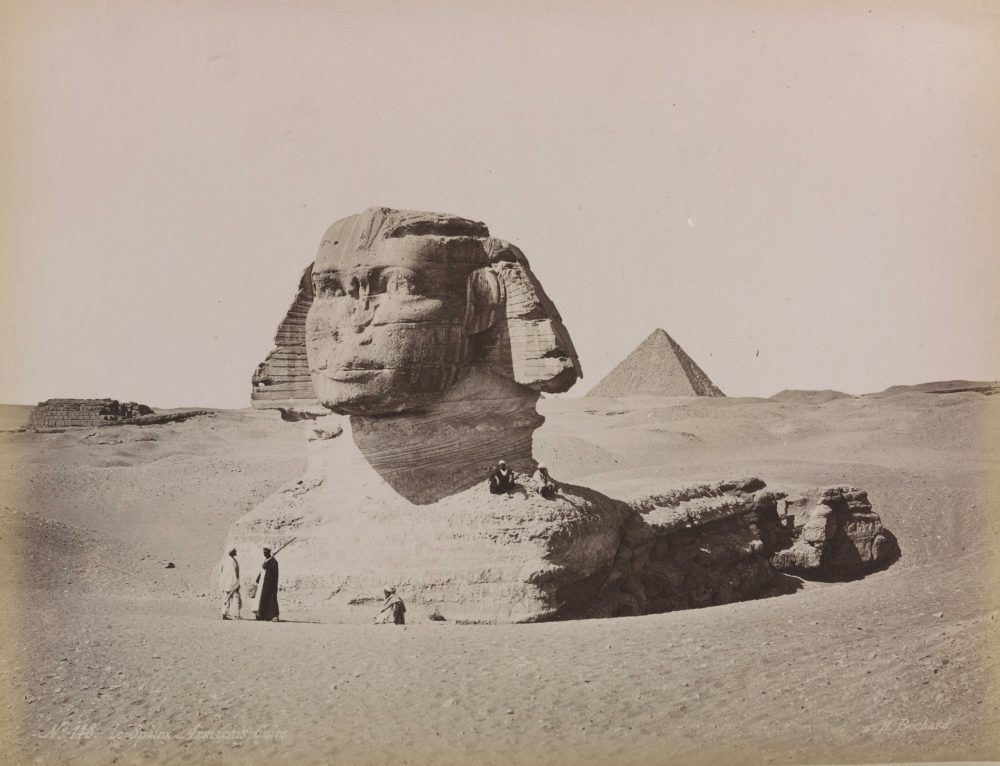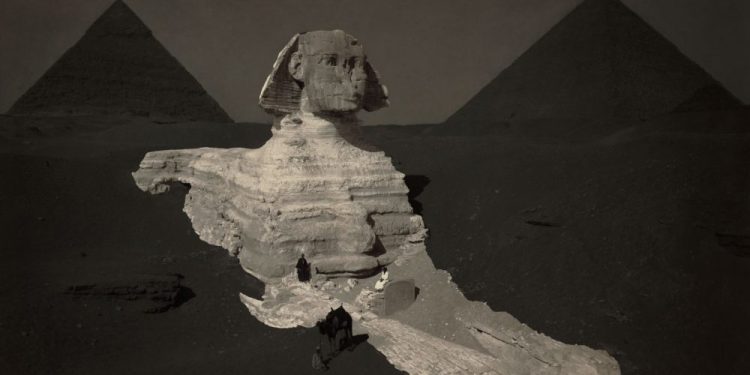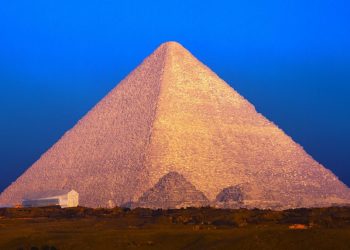The Great Sphinx of Giza is perhaps the only ancient monument on the planet’s surface that can outshine the Pyramids. It is the oldest known monumental sculpture in Egypt, and it is shrouded in mystery. The gigantic limestone statue depicts a mythical creature carved with the body of a lion and what is believed to be the head of a human. Facing from West to East, the Great Sphinx guards the Pyramids of Giza since time immemorial.
73 m (240 ft) long from paw to tail, 20 m (66 ft) high from the base to the top of the head, and 19 m (62 ft) wide at its rear haunches, the Great Sphinx of Giza is a statue unlike any other. Everything we know about it is archaeological guesswork; the Great Sphinx is absent from the historical record of ancient Egypt entirely.
There isn’t one ancient document, hieroglyph, or text that references the ancient statue thought to have been carved around 4,500 years ago, during the Fourth Dynasty Reign of King Khafre, the man who is said to have commissioned the second-largest pyramid at Giza.
The Great Sphinx is considered one of Earth’s largest and oldest statues, although much of its origins are shrouded in mystery. We don’t know who it was built for, what its purpose was, when it was exactly built, nor do we know what it was called in the distant past.
Although many Egyptologists attribute the Sphinx to the creation of Pharaoh Khafre, it is impossible to confirm since there are no records that mention the Sphinx and Khafre. Futthermor4e, it is impossible to identify the exact name its creators gave it when it was complete.
The Great Sphinx does not appear in any known writing of the Old Kingdom, and there are no engravings explaining its construction or its primary purpose. Therefore, everything we know about the Sphinx comes from when the statue was already ancient to the ancient Egyptians. For example, we know that during the New Kingdom, the Sphinx was worshiped as the solar deity Hor-em-akhet.
Despite being one of the most important statues in ancient Egypt, the history of the Great Sphinx is shrouded in complete mystery, and no one has been able to explain the absence of the ancient statues from the historical records of Egypt.

The name we use today to refer to the Sphinx was given to the statue in classical antiquity, several thousand years after the statue was initially carved. Its original name doesn’t appear anywhere in the history of Egypt, and there are no written accounts that mention the ancient statue before the 18th dynasty of Egypt.
During this time, when Pharaoh Thutmose IV excavated the Sphinx, which was buried beneath the sand, the Sphinx was already ancient and deteriorated. The statue is so old that its first restoration is thought to have taken place more than 3,500 years ago.
In other words, when famous Pharaohs such as Ramesses the Great or Tutankhamun ruled over the land of Pharaohs, the Great Sphinx was an ancient statue shrouded in mystery. However, excavations around the Sphinx can be traced to 1,400 BC, when Thutmose IV excavated the statue after a great effort.
He crafted a limestone stele to honor the ancient statue and placed it in front of the Sphinx, between its paws. This stele is known as the Dream Stele.
The above is evidence that the Sphinx spent thousands of years buried and was excavated and buried over and over again. This also suggests that the Sphinx is extremely old. The fact that some of the first restorations took place around 3,500 years ago indicates that the Sphinx was already deteriorated by then. Nonetheless, given the lack of records, it is impossible to know how old the statue is.
Nonetheless, Egyptologists like to believe the Sphinx was commissioned by Khafre, despite ample evidence pointing otherwise. In 1949, Egyptologist Selim Hasan excavated the Sphinx and its surroundings, and his discoveries were recorded in his book “The Sphinx: Its history in the light of recent excavations.”
In his work, Hassan explained the problem of dating the Sphinx and tracing it back to a particular Pharaoh in ancient Egyptian history:
Taking all things into consideration, it seems that we must give the credit of erecting this, the world’s most wonderful statue, to Khafre, but always with this reservation: that there is not one single contemporary inscription which connects the Sphinx with Khafre; so, sound as it may appear, we must treat the evidence as circumstantial, until such time as a lucky turn of the spade of the excavator will reveal to the world a definite reference to the erection of the Sphinx.

Despite mainstream Egyptologists claiming that the Sphinx is not older than Egypt’s Fourth Dynasty, excavations at and around the Sphinx in the past revealed conflicting data. Some of the first Egyptologists to have studied the Sphinx concluded on many occasions that the Sphinx most likely predated the Fourth Dynasty reign of Khafre.
Egyptologist Sir Flinders Petrie wrote in 1883 about the age of the nearby temples and the Sphinx: “The date of the Granite Temple [Valley Temple] has been so positively asserted to be earlier than the fourth dynasty, that it may seem rash to dispute the point.”
French Egyptologist Gaston Maspero, the second director of the Egyptian Museum in Cairo, studied the Sphinx in 1886 and concluded that since the Dream Stela showed the cartouche of Khafre in line 13, it was Khafre who excavated the Sphinx and that the statue must, therefore, predate Khafre and his predecessors and possibly the entire Fourth Dynasty reign.
In other words, Maspero believed that the Sphinx was much more ancient than the fourth Dynasty reigns of Khafre, Khufu, and Sneferu.
But Maspero and Petrie were not alone in their belief that the Sphinx was much more ancient than the Fourth Dynasty. English archaeologist and Egyptologist E. A. Wallis Budge recognized that the Sphinx predated Khafre’s reign. Wallis Budge wrote in his 1914 book The Gods of the Egyptians (1914):
“This marvelous object [the Great Sphinx] was in existence in the days of Khafre, or Khephren, and it is probable that it is a very great deal older than his reign and that it dates from the end of the archaic period, around 2686 BC.”
Maspero believed that the Sphinx was so ancient that it could very well be “the most ancient monument in Egypt.”
The Great Sphinx of Giza, guardian of the pyramids and one of Earth’s most ancient statues, is absent from Egypt’s historical record. But why?
However, it was perhaps Egyptologist Miroslav Verner who best described the Sphinx and its significance:
The Great Sphinx of Giza is more than simply a symbol of ancient and modern Egypt. It is the very embodiment of antiquity and mystery itself. Over the centuries it has fired the imaginations of poets and scientists, adventurers and travelers. Although it has often been measured, described, investigated using the most up-to-date scientific technical means, and discussed at special scientific conferences, fundamental questions remain unanswered: Who built it, when, and why? (234).
The Great Sphinx of Giza is and remains one of the most incredible ancient statues on Earth. Its complete absence from ancient Egypt’s historical record is perhaps an essential tell-tale sign that suggests the ancient statute originated in a time when even the pyramids of Giza were not even built. Perhaps, as Maspero suggested, the great Sphinx predates the entire Egyptian civilization.
Join the discussion and participate in awesome giveaways in our mobile Telegram group. Join Curiosmos on Telegram Today. t.me/Curiosmos











